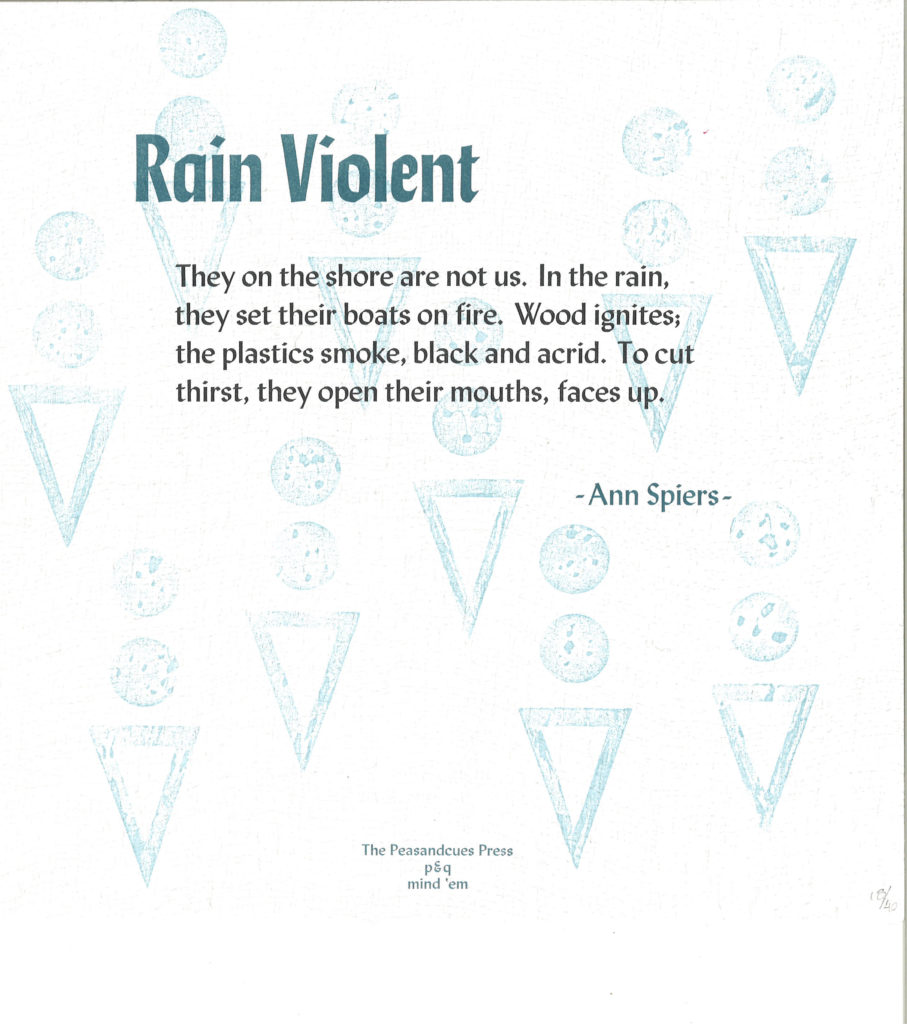For Summer Solstice, the on-line journal Canary has published a poem from my cycle Rain Violent. See the issue at http://canarylitmag.org/
Weather Station on a Plain

My dad discovers gold in an aerosol can.
Like Midas, he gilds all. The ozone thins.
I ride my golden bike, my skin bronzing
under the ultraviolet rays of the sun.
Above my poem, “Weather Station on a Plain,” is an icon from the International Weather Symbols. This poem belongs to a cycle in which the poems also use symbols from the same coding system. These symbols exist for many categories depicting the surface weather, such as the other types of weather stations (Deep Valley, Coast, Plain) and those that show the amount and intensity of drizzle, fog, rain, and thunder. My hope is that the symbols inject each poem with depth, counterpoint, and link to specific climate phenomena as the poem details today’s climate crisis.
The International Weather Symbols are the visual code used to map surface climate conditions observed at local weather stations worldwide. The World Meteorological Organization (WMO) oversees this coding system. The data illustrated include cloud type and cover, temperature, precipitation, wind speed and direction, atmospheric pressure, precipitation type and amount. Plotted on a page, the visuals use a prescribed placement of symbols outside a central circle to record surface weather conditions at one time and one place.
The complexity of the maps ranges from eight to many notations, depending on the station’s purpose and instrumentation. Observations are made once or twice a day or, given today’s capabilities, second to second.
These stationary weather stations, numbering in the tens of thousands, are sited in citizen scientists’ backyards and fields, on sea buoys and ships, and at universities and meteorological institutions. Making further data available for surface weather maps are today’s computer systems and software, affordable instrumentation, open reporting systems, satellites, and GIS. Weather hobbyists have always been the most numerous data recorders and sharers. The data are used for research as well as by airplane pilots, sea captains, ground transports, and citizens to chart the safest course.
In the mid-1800s, inventors added to the collection of instruments measuring weather. This growing ability to gather weather data was available and affordable, as it is today, to both amateur and professional weather watchers. In the 1840s, weather watchers used another new invention, the telegraph, to transmit observations to regional, national, and global agencies. Combined, the data produce weather maps of wider geographical areas. With the new source of data, newspapers printed weather maps; weather forecasting emerged from the compilations. By 1941, global consensus was reached on the symbols and their meanings. On-line now, numerous networks collect the surface-weather reports.
Today globally, surface-weather maps indicate that climate warming occurs based on the local weather stations’ very local data. Debate rages about the data’s accuracy from the thousands of worldwide stations.
For an example of the weather station maps, see https://www.wpc.ncep.noaa.gov/html/stationplot.shtml

Rain Violent, Broadside from Peasandcues Press, Vancouver
The broadside Rain Violent, from Peasandcues Press (Longview WA), was designed by Marquita Green and printed by Joseph Green. Its background is light cloth-weave sandigraph and overprinted with Marquita’s linocut of the Rain Violent symbol.
The poem Rain Violent is from Ann’ manuscript, “Weather Station,” poems paired with the 99 International Weather Symbols. The poems explore the physical, personal, and cultural effects of climate change.

See Ann’s poem Dressing the Salmon Queen
Knee deep in seaweed,
she slid with each step,
stuck in wrack so fresh
isopods still twitched
on the slippery surface…
Stealing Light: A Raven Chronicles Anthology, Selected Work from Summer 1991 — Fall 1996, edited by Kathleen Alcalá, Phoebe Bosché, Paul Hunter, and Stephanie Lawyer. The anthology includes the poems, essays, fiction, interviews, and storytelling from 92 writers, and the artwork / illustrations of 26 artists. From 1991 to 2018, for twenty-seven years, we published forty-eight issues of the journal Raven Chronicles.

See Ann’s poem Chatuchak Market, Bangkok
her blood a second
screening
of red marking
mulberry paper black lines
crookedly
her path…
__________________________________________________________________________________________
Rain Freezing Slight

Nettles collapsing in the long loss
Winter wrens quiet their soft sing. Rain
silvering blue iris, and the crow’s cra’ack
recedes. What Tiresias saw was this.
Drizzle Thick

Mary loses her face first, Jesus
last. The pieta erodes to a curve
holding an agony. Rain dissolves
Golgotha’s small wounds.
From manuscript Weather Stations’ 61 poems. Each poem’s icon and title are from the International Weather Symbols and other climate symbols, all used when climate notations were hand written at or chart numbers telegraphed worldwide from weather station in the day’s log.
“Calm,” “Ground Covered with Thawing Snow,” “Haze, “Sky Overcast,” “Visibility Reduced by Smoke.” Written River. Hiraeth Press, 2016. http://hiraethpress.com/store/books/written-river-issue-10.
“Clouds Dissolving,” “Ground Flooded,” “No Clouds,” “Stratocumulus Not from Spread of Cumulous.” Water Water Everywhere, 2015. https://waterpoetryprose.wordpress.com/2015/12/12/ann-spiers/
“Dust Devils,” “Eddies,” “Snow Granular.” Kudzu #5, 2015. http://quarterly.kudzuhouse.org/summersolstice/5.2/5.2.html
“Dust Raised by Wind,” “Fresh Snow.” Hummingbird. V26 #2, 2017.
“Rain freezing” (the moon’s ragged edge). Modern Haiku. #46.2 Sp/Su, 2015.
“Rain Violent.” Broadside. Peasandcues Press. Designed/Printed by Marquita /Joseph Green, Vancouver WA. 2015.
“Thunderstorm with Dust Storm,” “Wind Out of the North.” Bricolage. Issue 36, 2018.
“Weather Station on the Coast,” “Weather Station on a Plain (forthcoming). #43,2018-9. http://canarylitmag.org/archive_by_issue.php?issue=43 Accent 2;